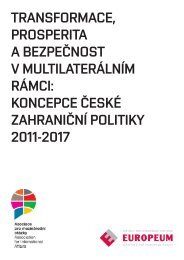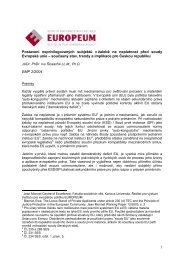eu constitutionalisation - EUROPEUM Institute for European Policy
eu constitutionalisation - EUROPEUM Institute for European Policy
eu constitutionalisation - EUROPEUM Institute for European Policy
Create successful ePaper yourself
Turn your PDF publications into a flip-book with our unique Google optimized e-Paper software.
Chapter 5: The <strong>European</strong> Constitution and the Re<strong>for</strong>m of External CompetencesThe provision on the CCP in the CT in fact aspired to resolve the compromiseadopted in the Nice-version, between those who felt that theUnion’s external powers were unnecessarily limited through the Court’sruling in the WTO-Opinion and those who dreaded a further extensionof the Union’s competences. It seems that the Convention, after the drawbackof Opinion 1/94, tended to take up the extensive interpretation ofexclusivity first adopted by the ECJ in Opinion 1/78, according to which“a commercial policy, based on uni<strong>for</strong>m principles must be governed from a widepoint of view […].”⁶⁷ The CT would undoubtedly broaden the Union’seconomic external powers, and thus its margin of mano<strong>eu</strong>vre in the fieldof international trade, to a considerable degree. Last but not least, theproposal would entail one significant gain, namely to simplify the current“legal monstrosity”⁶⁸created under the Nice Treaty.V.4. Chapter IV: Cooperation with Third Countriesand Humanitarian and Aid (Art. III-316 to III-321 CT)V.4.1 IntroductionChapter IV of Title V on the Union’s cooperation policies covers one ofthe main pillars of EU external action. Measures adopted on the basis ofthese provisions extend to practically all countries in the world and coverall essential areas of cooperation with third countries, including economic,social and political aspects. The Union’s cooperation policy is thus anotherfield which displays the strong link between trade or economic relations and<strong>for</strong>eign policy aspects.⁶⁹ Articles III-316 to III-321 CT essentially reflect theprovisions on development cooperation in the current Art 177 TEC, as wellas economic, financial and technical cooperation with third countries in Art181a TEC. Art. III-321 CT moreover introduces a new competence provisionon humanitarian aid, <strong>for</strong> cases of ad hoc assistance, relief and protection <strong>for</strong>people in third countries and victims of natural or man-made disasters.67) Opinion 1/78, 4 October 1979; ECR 1979/2871, para 45. In this paragraph the Court also states that“a restrictive interpretation of the concept of Common Commercial <strong>Policy</strong> would risk causing disturbancesin intra-Community trade by reason of the disparities which would then exist in certain sectors of economicrelations with non-member countries.”68) HERRMANN (2004), p.2 (loose translation).69) Compare the statement of the Commission and the Council, available at http://www.<strong>eu</strong>ropa.<strong>eu</strong>.int/comm/development/index_en.htm, according to which it is the task of the Community to ensure that developmentpolicies and trade and investment policies are complementary and mutually beneficial (p.6).176Chapter 5: The <strong>European</strong> Constitution and the Re<strong>for</strong>m of External CompetencesThese provisions have been the result of a gradual development ofthe Community’s cooperation policy. In its original version and untilMaastricht, the TEC did not contain any specific legal basis <strong>for</strong> developmentcooperation or cooperation with third countries. The developmentof policies in these areas was largely based on (current) Art 310 TEC(Association Agreements)⁷⁰ or Art 133 TEC (Common Commercial<strong>Policy</strong>).⁷¹ Yet evidently, it conflicts with the very purpose of Art 310 TECto conclude association agreements with all developing countries. Also theCCP is not the appropriate legal basis to cover all aspects of developmentpolicy. Maastricht finally introduced the current Art 177 TEC and establisheddevelopment cooperation <strong>for</strong>mally as an area of Community policy.⁷²Its objectives included amongst others the sustainable economic and socialdevelopment of the developing countries, the campaign against povertyand the gradual integration of these countries into the world economy. Itthus offers a broad margin to define the actual content of cooperation withthird countries.⁷³ Moreover, as is emphasised in Art 177(2) TEC, the objectivesof development cooperation are taken into account in all Communitypolicies which are likely to affect developing countries. Above all, this refersto the delimitation between development cooperation and the CommonCommercial <strong>Policy</strong>, or the close co-existence between trade, economic ortechnical cooperation and other <strong>for</strong>ms of cooperation intended to strengthendemocratic and human rights values in third countries.70) Compare <strong>for</strong> example the earlier Lomé Conventions which have been now replaced by the so-calledCotonou-Agreement with the ACP-countries (Council Decision 2003/159/EC of 19 December 2002 concerningthe conclusion of the Partnership Agreement between the African Caribbean and Pacific Group ofStates, of the one part, and the <strong>European</strong> Community and its member states, of the other part, signed inCotonou on 23 June 2000) which is also based on Art 310 TEC; Compare hereto SCHMALENBACH (2002),ad Art 177 (in Callies/Ruffert, Kommentar zu EUV und EGV, 2nd Edition, Luchterhand), para 3.71) Compare, <strong>for</strong> example the Council regulation on the cooperation agreement with the Asian and LatinAmerican countries which are based on Art 133 in conjunction with Art 181 (Council Regulation (EEC) No1440/80 of 30 May 1980 concerning the conclusion of the Cooperation Agreement between the <strong>European</strong>Economic Community and Indonesia, Malaysia, the Philippines, Singapore and Thailand – member countriesof the Association of the South-East Asian Nations, OJ L 144/1; also the regulation on the GeneralisedSystem of Preferences (Regulation 2501/01, OJ L 346/1) is based on Art 133 TEC, although it pursuesdevelopment policy objectives; compare moreover the Court’s broad approach on CCP in Opinion 1/78,4 October 1979; ECR 1979/2871.72) For an historical background on the development cooperation, refer to MARTENCZUK (2002), Cooperationwith Developing and Other Third Countries: Elements of a Community Foreign <strong>Policy</strong> (in Griller/Weidel,External Economic Relations and Foreign <strong>Policy</strong> in the <strong>European</strong> Union, Springer Wien/New York).73) Compare, by contrast, the narrow interpretation of the Court regarding the scope of Community competencein development cooperation in Case C-268/94, Portugal versus Council, [1996] ECR I-6177, para 39(in this context: MARTENCZUK (2002), p.393).177








